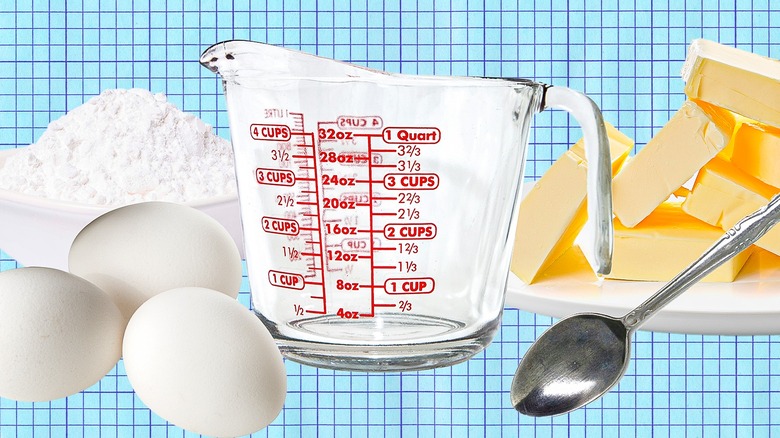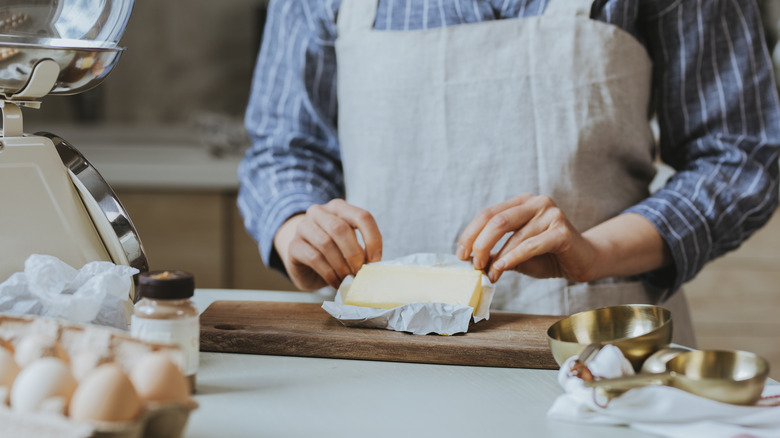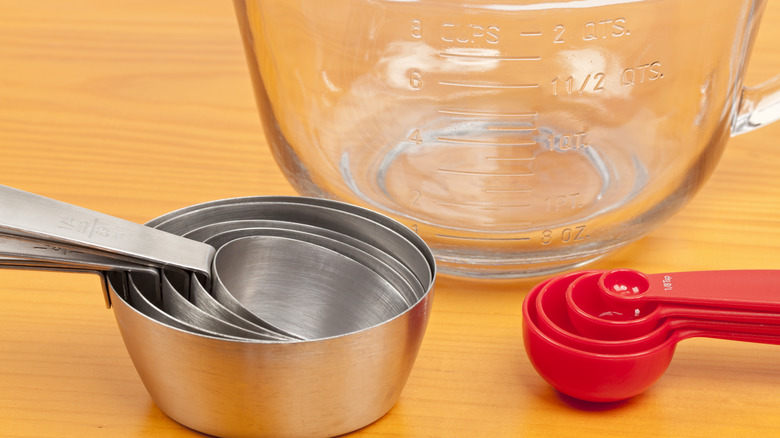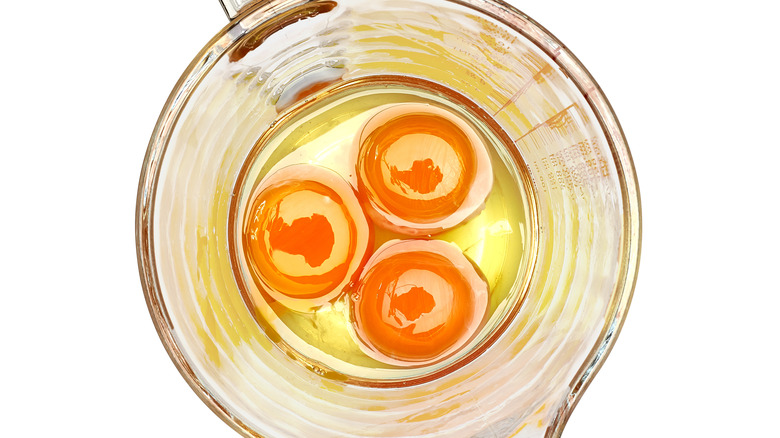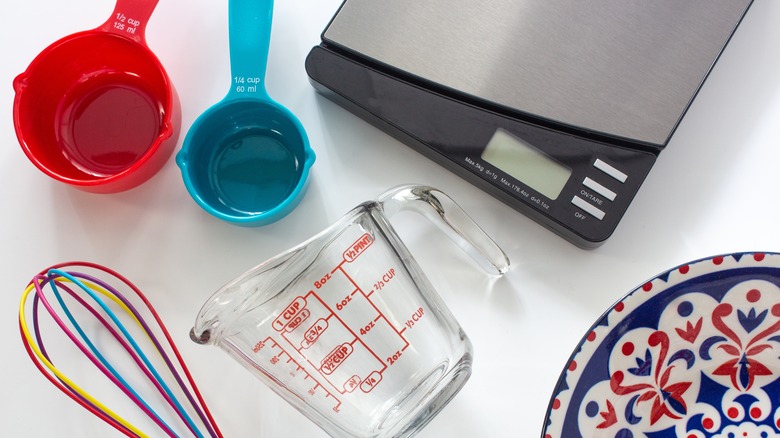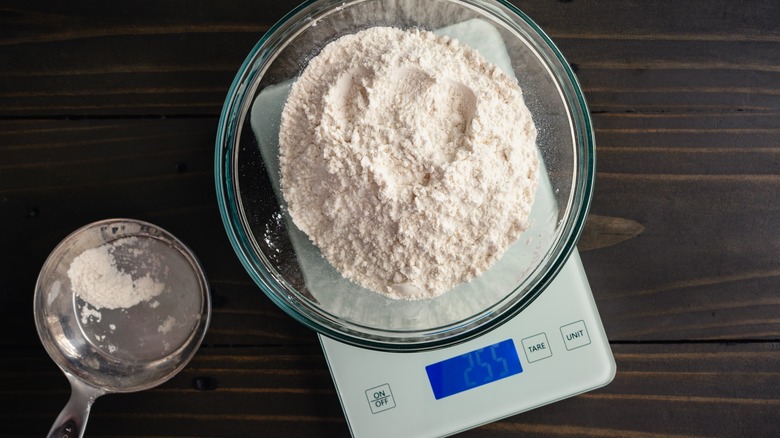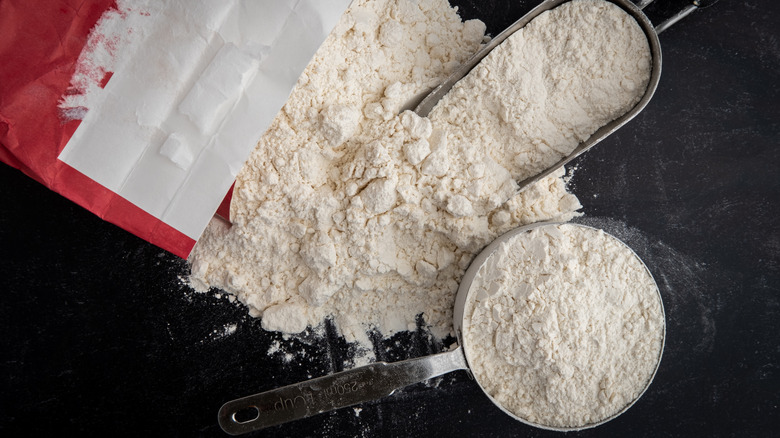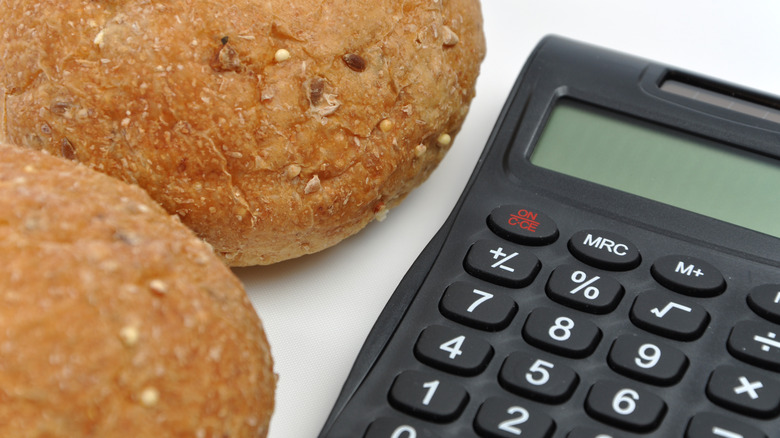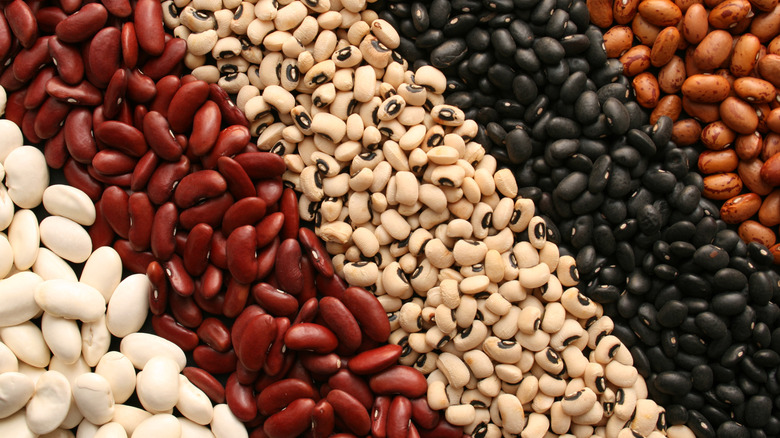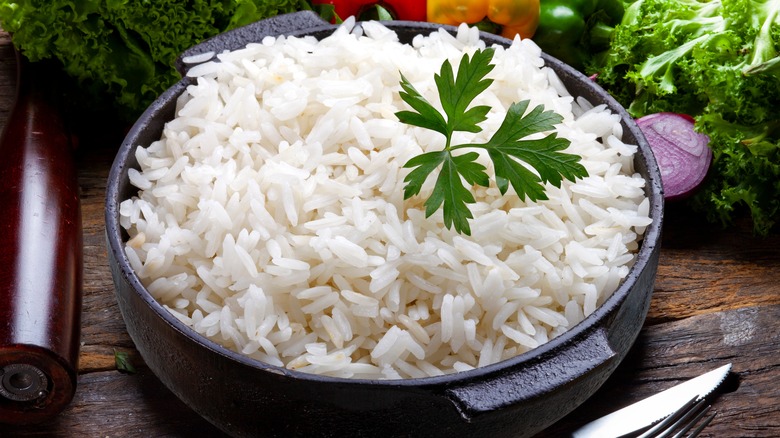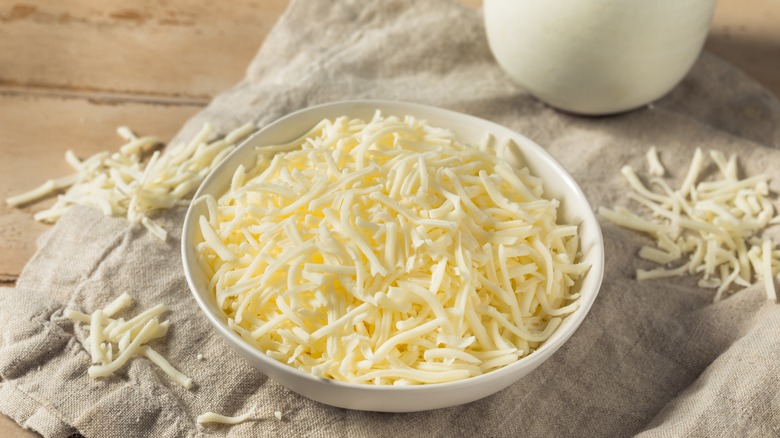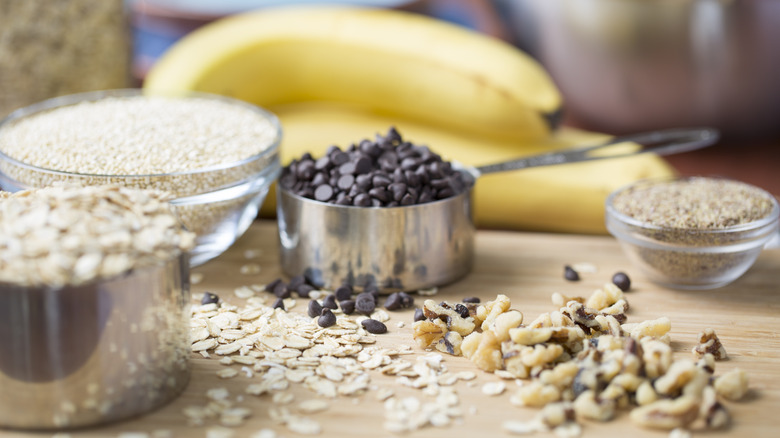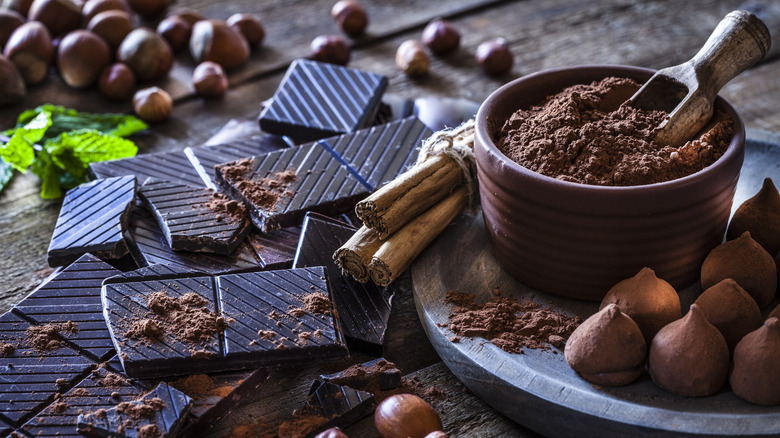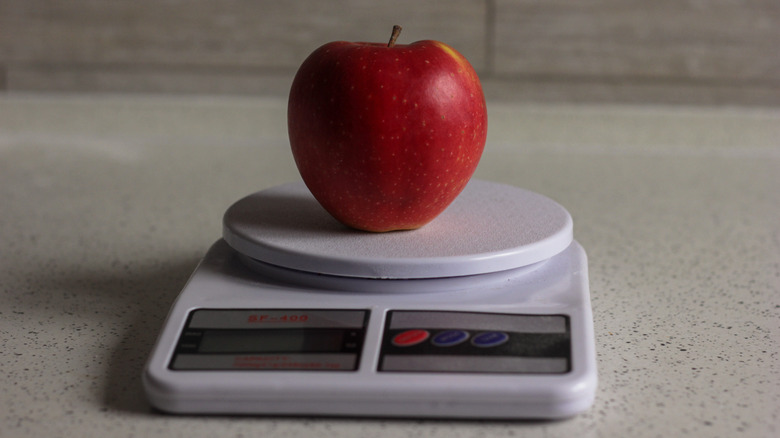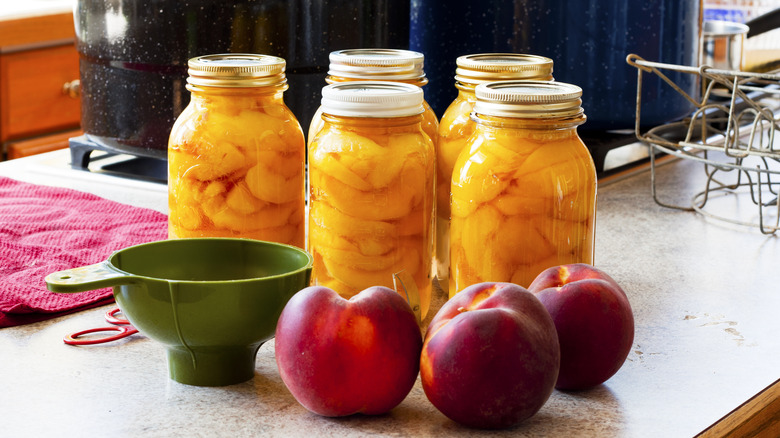Baking And Cooking Measurements Every Home Chef Should Know, According To A Trained Chef
Cooking and baking involve a lot of measuring. Baking borders on being an exact science, where an error in measurements can mean the difference between success and failure. Cooking is more forgiving, on the whole, though a recipe may not turn out as intended if you've played too fast and loose with your measurements.
Working professionals, whether cooks or bakers, memorize a lot of measurements simply because we don't have time to stop and think about them. I can attest to this as a trained chef, former restaurateur, and sometimes commercial baker.
In your home kitchen, you won't face that kind of time pressure, so you can give your memory a break. By all means, memorize the measurements you use a lot (it helps!), but most of the time, you'll just need to bookmark a quick reference that covers a good cross-section of them. Here are 14 useful sets of measurements for home cooks, culled from lots of Google searches and then filtered through my professional experience.
How many sticks of butter equals a cup?
We'll start with an easy one. Remember the old saw that "a pint is a pound, the world around"? Well, it's not entirely true, but it works well with butter. A pint is 2 cups, and so is a pound of butter. Butter is almost always sold in sticks, so here's how that pound breaks down into the kind of useful measurements you'll see in recipes:
1 pound = 2 cups = 4 sticks
1 cup = 2 sticks
1 stick = ½ cup = 8 tablespoons
¼ cup = ½ stick
Thirds of cups are a bit trickier to calculate because they don't break down neatly into sticks or tablespoons. Doing the math, then:
⅔ cup = 5.33 ounces = 1 stick, plus 2 tablespoons and 1 teaspoon
⅓ cup = 2.66 ounces = ½ stick, plus 2 teaspoons
If you use margarine for your baking, those square blocks are also ½ cup each, like sticks of butter, so the math works out the same.
How many tablespoons per cup?
One of the most important measurements in recipe-dom is the eight-ounce cup. If you have a decent set of measuring cups and another of spoons, all in different sizes, you can usually complete any recipe you need to. Scaling recipes up and down or working out fractions of a cup by the spoonful if you don't have a measuring cup in that size takes a little more effort. Here's how the math breaks down.
1 cup = 8 ounces = 16 tablespoons = 48 teaspoons
½ cup = 4 ounces = 8 tablespoons = 24 teaspoons
⅓ cup = 2.66 ounces = 4 tablespoons plus 2 teaspoons = 14 teaspoons
1 tablespoon = 3 teaspoons
It's also important to know that while we often speak of our smaller spoons as teaspoons and our larger spoons as tablespoons, the types of spoons you use to eat your meals aren't standardized. You shouldn't use them to measure ingredients except in situations where rough guesses are good enough (in which case you can approximate a teaspoon with just your hand).
How many eggs makes a cup?
Most recipes call for eggs individually, but there are some notable exceptions. Large-volume recipes may call for an entire cup of eggs or a half-cup of whites, for example. Some recipes, especially those intended for professionals, give weights rather than volume measurements. You may also need to scale egg-based recipes up or down (which gets complicated) or adapt a recipe to use different-sized eggs. Here's how all of those measurements work.
1 cup = 4-5 large eggs = 6-7 whites = 12-14 yolks
1 large egg = 1 ⅔ fluid oz.
1 large white = 1 fluid oz = 2 tablespoons
1 large yoik = 1 tablespoon
½ egg = 1 ½ tablespoons beaten egg
⅓ egg = 1 tablespoon beaten egg
There's some variation in the larger measurements because large eggs (and all the other sizes) are graded by weight per dozen, with their shells on. So then, if you're measuring by weight or converting between sizes:
1 pound = 10 whole eggs, shelled = 14 whites = 26 yolks
12 large eggs = 10 X-large=14 medium = 16 small
What's the difference between an ounce of fluid and an ounce by weight?
Recipes in the U.S. may use ounces for weight or volume and don't always specify which (metric countries have it easier). Fluid ounces measure volume – the space something takes up – while regular ounces measure weight, but there is a loose relationship.
Two cups of water (or juice or milk) weigh just over a pound, by about ⅔ of an ounce. You can even use water and a scale to test your measuring cups' accuracy. Other ingredients vary, depending on their density. Canola oil weighs less, at about 15 ⅓ ounces per pint. Cement is very dense at about 1 ½ pounds per pint, though we don't recommend cooking with it. Your best bet, when the type of ounce is unclear, is to cross-check your current recipe against others to see what they call for.
Then there's the question of dry versus liquid measuring cups. They both measure by volume (fluid ounces), but they're made differently. Dry cups are measured right to the brim, so you can fill them with your ingredients and level them. Liquid measuring cups have extra space, so you can measure out a full cup and still have some "wiggle room" to not spill it. You'll spill if you measure liquids in a dry cup, and you won't be able to level for accuracy if you measure dry ingredients in a liquid cup.
How heavy is a cup of flour?
As we can attest, having baked commercially on a small scale, professional bakers weigh their ingredients rather than measuring in cups. That's because it's tricky to measure flour properly, and it's imprecise even when you do it right. We've demonstrated this frequently in our cooking classes, and one person's cup of flour can weigh as much as 30% to 40% more than the next person's.
This is why you should bake with a scale, but that raises a new issue. For most of us, the favorite recipes we've accumulated over the years or learned from our mothers are measured in cups. So, to change those over to weight measurements, you'll need to know the weights of things like flour, confectioner's sugar, brown sugar, and eggs (which we've covered elsewhere). Rule of thumb weights for these ingredients (according to the experts at King Arthur Flour) are:
1 cup all-purpose flour = 4 ¼ ounces = 120 grams
1 cup whole wheat flour = 4 ounces = 113 grams
1 cup confectioner's sugar, unsifted = 4 ounces = 113 grams
1 cup brown sugar, tightly packed = 7 ½ ounces = 213 grams
Bear in mind that these are approximations (and many sources add an extra ½ ounce to the weight of flour). To know what cups of flour weigh, the way you personally scoop them, weigh several cups, and then average them.
How many cups of flour in a bag?
Here's a measure home bakers seldom consider, but it's useful in a surprising number of ways. It can tell you how much flour to buy for your holiday baking binge, for example, or what size of storage container you'll need to hold a given amount of flour.
Here's how the math works:
5 pounds flour = 80 ounces = approximately 18 cups, at 4 ¼-4 ½ ounces per cup
10 pounds flour = 160 ounces = approximately 36-37 cups, at 4 ¼ to 4 ½ ounces per cup
So, if your favorite holiday cookie recipe calls for 2 cups of flour, you can calculate that a 5-pound bag gives you enough for about nine batches. If you want to calculate how large a storage container you need, convert the number of cups into quarts. Now add an extra third or so – you'll usually buy a new bag before you run out completely – and the calculation looks like this:
5 pounds flour = 18 cups plus ⅓ = 24 cups = 6 quarts = 1 ½ gallons
10 pounds flour = 36 cups plus ⅓ = 48 cups = 12 quarts = 3 gallons
How do I change recipe fractions to decimals?
One of the trickiest things to do properly is scaling a recipe up or down to meet your needs. Some measurements are simple – a cup is easily halved or doubled – but others are more complicated. So your options are either to wing it (definitely a mistake to avoid) or to do the math properly.
Working with fractions is a bit of a headache for those of us whose memories of 4th-grade math are shaky (or traumatic), so here's the quick refresher you need. First, let's convert that fraction to a decimal. You simply divide the top number by the bottom number, and your calculator will spit it out for you. The common fractions work out like this:
¾ = 0.75
⅔ = 0.667
½ = 0.5
⅓ = 0.333
¼ = 0.25
Armed with those, you can easily multiply or divide cups or spoons of any ingredient by the appropriate number. You can also scale the fractions directly by multiplying or dividing the top number (the numerator). That doesn't always give you a neat answer, though — half of ¾ would be 1.5/4, which isn't especially helpful – so it's easier to go straight to decimals. Pro tip: this is a lot easier when you use a scale!
How to convert from dry beans to canned?
When your grocery budget is feeling stretched, beans are your friend. You'd be hard-pressed to name a food that packs so much nutrition for the dollar and keeps so well in your pantry until it's needed. Both dry and canned beans are inexpensive, but there's no question canned beans are more convenient when you need food on the table quickly. So, how do you convert your recipes from dry beans to canned?
It turns out there's a simple ratio that works for most beans. Daniel Gritzer of science-minded food site Serious Eats did the work so we won't have to, discovering that most beans roughly double in size when cooked. So:
1 cup dry beans = 2 cups canned/cooked (approximately)
1 pound dry beans = 3 cups (approximately) = 6 ½ to 7 cups canned/cooked
But canned beans aren't sold by the cup, so how does that translate into standard 15-ounce cans? Basically. 1 can = 1 cups drained = ¾ cup dry beans. That's also useful knowledge if you want to take your recipes in the opposite direction and enjoy the superior texture and flavor of dry beans. If a recipe calls for canned beans, allow 1 ½ cups per can and then cut that in half for the correct quantity of dry beans.
How much dry rice to cooked?
The best rice cookers make the popular grain easy to prepare, and even a cheap one can get the job done. What they don't do is tell you how much to make. So how does that work if you're figuring out portions for a given number of people?
According to USA Rice (the domestic industry's marketing board), you can expect dry rice to roughly triple in volume when it's cooked. Some varieties may yield more or slightly less, depending on how much water you use, but the difference won't usually be enough to leave you short (worst-case scenario, you make each portion slightly smaller or have a bit of leftover rice to use up). A ½ cup is the "official" portion size to count as one serving of grains, though real-world servings can be up to a cup (or more if you're from a rice-centric culture).
The other eternal question is how much water to use with your rice. USA Rice suggests ratios varying from 1 ¼ to 4 cups of water for every cup of rice, depending on the type. The common guidance is to use 2 cups of water for 1 cup of rice, which works only for long-grain rice, and even at that, we find the result is often too soft. Some recipes for simple white rice call for less water, and the larger the batch, the less water you need. We personally find 1 ½ cups of water to be ideal for most long-grain white rice.
How much shredded cheese is a cup?
Measuring milk in a cup is easy. Measuring sugar in a cup is easy. But what about cheese? It comes in a lot of different forms, and few of them are what we might call "cup friendly."
Before you can measure bars of cheddar, wax-coated wheels of gouda or wedges of hard, aromatic Parmesan, you'll need to shred them. This raises the kind of question that faces bakers with flour or brown sugar. How much is a cup? How firmly do I pack it?
Wisconsin's cheese marketing board has your back on this one:
Semi-hard cheeses (cheddar, Jack, anything shreddable): 1 cup = 4 ounces
Hard grating cheeses (Parmesan, Grana Padano): 1 cup = 3 ounces
Crumbled cheeses (feta, crumbly blue cheeses): 1 cup = 6 ounces
So when your recipes call for shredded cheese, break out the grater and make your own. Pre-grated cheese from the store is a convenient cheat, but it has additives to keep it from clumping, and those can sometimes keep it from melting as nicely as you'd like.
How many cups in a bag of chocolate chips?
Here's one that will crop up regularly for cookie lovers: recipes call for you to measure chocolate chips by the cup, but they're sold at the supermarket by weight. When it's your turn to send cookies or muffins to school, how will you know how many to buy?
Well, that standard 12-ounce bag you see on the shelf works out to approximately 2 cups of chocolate chips (or other "baking chips"). Some brands come in 11 ½ ounce bags (yay, "shrinkflation!"), which will leave you slightly short of 2 cups. Frequent bakers can find larger bags in sizes of up to 72 ounces, but the math is simple enough: every 6 ounces of chips equals 1 cup.
A complication is that chocolate chips come in different sizes, so if you're using something other than the standard size, the weight-to-cups ratio will change. Mini chips are much smaller than regular, so you'll need to cut back by about ⅓ to have the same weight of chocolate. Jumbos are bigger and fit fewer chips per cup, so you'll need to increase by ⅓ to have the weight of chocolate. Whichever size you use, of course, you'll improve your results by using the best chocolate chips you can find.
How much cocoa to use in place of chocolate?
There's an easy rule of thumb a lot of us follow when making sweet treats for social occasions: When in doubt, go with chocolate. It's almost always the safe option.
Baked goods can take a couple of routes to chocolate nirvana. One is through baking chocolate, measured in 1-ounce squares or blocks. Another is through the use of cocoa. So, if your recipe calls for one, and you have the other, how do you measure equivalents?
Here's the rule when substituting cocoa for chocolate: 1 ounce unsweetened baking chocolate = 3 tablespoons cocoa + 1 tablespoon fat
If you're going the other direction and using chocolate, you'd use one square for every 3 tablespoons of cocoa and reduce the recipe's fat by 1 tablespoon for each square of chocolate (because the chocolate contains cocoa butter). If you have both the natural and Dutched types of cocoa powder, natural gives a stronger flavor with a hint of bitterness, while Dutched lends a mellower flavor but a darker color. Choose accordingly.
How many apples per pound?
When you're picking out a recipe for apple pie or an apple-filled coffee cake, it will usually tell you the number of apples you need. But apples are sold by the pound, so knowing how many apples are in a pound is useful for budgeting purposes (or when you're making more than one pie).
Apples vary from quite small to grapefruit-sized, so let's focus on standard, medium-sized supermarket apples. You'll average three apples per pound with those, and though there's some individual variance, that's close enough for most recipes. Having made the experiment in our cooking classes, we can attest that it's also applicable to medium onions (apple-sized, in fact) or mid-sized bananas roughly 5 to 6 inches in length.
Oranges are harder to gauge because they're juicy and heavier for their size. They're graded by "count," meaning how many you get in a 40-pound case. Medium-sized 88-count oranges, the most common size you'll see in stores, run 6 to 7 ounces each, so there are roughly 2 ½ per pound.
How much produce to buy for canning?
The modern food system means that few pieces of produce remain truly seasonal, but fruits and vegetables will always be at their freshest and most plentiful when your local farms and orchards are harvesting. The idea of capturing that bounty (and stretching your grocery budget) is what makes home canning so beguiling.
Some question if home canning is cost effective, but jars and a canner will last for years once you've made that initial investment. That means your ongoing costs are limited to your time, fresh lids, and — of course — produce to can. It's a measurement that doesn't crop up on most measurement and conversion lists like this one, so here's how many Mason jars you'll fill for several common fruits (you're welcome).
Apples: 1 peck = 8 pints/4 quarts sliced apples = 16 pints/8 quarts applesauce
Pears: 1 peck = 5-6 quarts/10-12 pints
Peaches: 1 peck = 4-6 quarts/8-12 pints
Cherries: 1 lug = 6-8 quarts/12 to 16 pints
Blueberries: 6-quart tray = 3-4 quarts/6-8 pints
A peck is ¼ of a bushel, so if you have the opportunity to purchase by the bushel (and will eat that much), you can simply multiply by four and then start getting your kitchen ready for canning!
